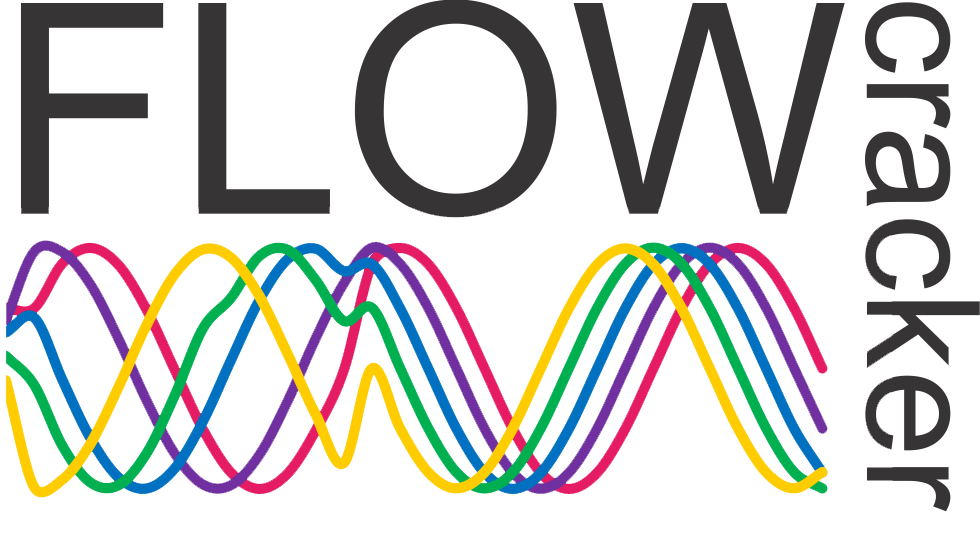

At Flow Cracker, “FLOW” is more than just our favorite word—it’s our guiding principle. But why do we emphasize flow over traditional management metrics like productivity scores, utilization rates, or efficiency KPIs, or popular Agile metrics like velocity, story points, or burndown charts?
Think about a piece of music. When every instrument is perfectly synchronized, a melody emerges effortlessly—predictable yet dynamic. Conversely, a single mistimed note or pause can disrupt the rhythm, creating friction rather than harmony. Organizations experience similar dynamics. In product and engineering teams, minor disruptions—those subtle wait states, unclear handoffs, or hidden dependencies—can snowball into systemic noise, undermining delivery, morale, and outcomes.
Our logo encapsulates this metaphor. On the left, distorted rainbow-colored waves symbolize the inherent complexity and noise of real-world systems. On the right, smooth sine waves represent clarity, alignment, and sustainable rhythms of delivery. The journey from chaos to coherence—from noise to sine waves—is precisely the shift we help organizations achieve.
In this post, we explore how tuning into organizational flow—through rhythms, team dynamics and busting wait states—offers far better signals of health than any dashboard can. We don’t chase Agile velocity. We coach for sustainable flow. Here’s why that distinction matters.
Flow: More Than Speed, It’s Rhythm and Alignment
Too often, leaders equate flow with speed—how quickly tasks move through a system, how fast teams deliver, or how rapidly milestones are met. But true flow isn’t merely about acceleration; it’s about rhythm and alignment. Picture a professional rowing crew in perfect synchronization: every stroke matches the others, and the boat moves effortlessly. The secret to their success isn’t brute force; it’s balance.
Organizational flow is about achieving sustainable rhythms of work and consistent alignment across teams, processes, and objectives. It involves recognizing how smoothly value moves from one part of your system to another—and how clearly individuals understand their contributions within the broader context.
Flow Cracker helps shift the conversation from “How fast?” to “How smoothly?” It’s a subtle yet powerful change that reveals bottlenecks, improves alignment, and builds systemic health—without burning teams out.
Distortion to Clarity: Using Sine Waves to See Flow
Why sine waves? Because they reveal what metrics can’t.
Imagine tuning a radio from static to a clear channel. The initial distortion represents the friction and misalignment most organizations operate in by default—unseen, yet costly. As you tune closer to the right frequency, the signal becomes clear. The wave smooths out. Alignment emerges.
That’s what sine waves symbolize in our work. On the left: distorted, chaotic, unpredictable noise. On the right: coherent, rhythmic, and sustainable flow.
Teams with clear rhythms and minimal distortion operate with trust, timing, and clarity. Teams with distorted signals struggle with hidden wait states, fractured communication, and priority confusion.
Sine waves give us a powerful way to visualize and diagnose this. They make flow visible—and improvement possible.
Best Practices for Cultivating Organizational Flow
You don’t chase flow—you design for it. Here are some of the practices we’ve found essential:
- Coach leaders to think in flow
Train executives and middle managers to see systems, not silos. Leadership that tunes into flow drives lasting transformation. - Visualize work as interconnected flow
Use Kanban or flow-based visuals, not just backlogs. Focus on the movement of value, not just the status of tasks. - Identify and reduce wait states
Surface and eliminate bottlenecks that cause work to pause unnecessarily. Often, these are hidden in handoffs and approval loops. - Stabilize and synchronize rhythms
Align planning cycles, review cadences, and delivery expectations across teams to avoid chaos and fragmentation. - Listen to human signals
Watch for qualitative cues—burnout, team friction, communication gaps. These often precede hard performance failures. - Build a culture of safe experimentation
Encourage teams to experiment with small changes in how they work. Flow improves when teams feel ownership and autonomy.
Reflect, Experiment, Act — Tuning into Your Organization’s Flow
Flow is not a luxury—it’s your organization’s lifeline.
When you move beyond noisy dashboards and distorted incentives, you begin to see the true rhythm of your teams. You spot the gaps between intention and execution. You understand what truly enables—or blocks—value from flowing to your customers.
At Flow Cracker, we believe that flow is the most honest signal of system health. And we’re here to help you hear it.
So Reflect. Experiment. Act.
Because once you tune into flow, you don’t go back to noise.
